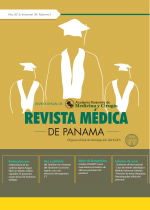Omeprazol a dosis estandar vs infusión continua para la prevención de hemorragia recurrente en úlcera péptica sangrante
Autores/as
DOI:
https://doi.org/10.37980/im.journal.rmdp.2014161Resumen
Resumen
Introducción: El tratamiento farmacológico después de la terapia endoscópica de la hemorragia por úlcera péptica es controversial, se recomienda el omeprazol a altas dosis. Objetivo: El propósito del presente estudio fue evaluar la eficacia del tratamiento con omeprazol administrado en diferentes dosis, para la prevención de hemorragia recurrente. Materiales y Métodos: Se realizó un ensayo clínico aleatorizado controlado simple ciego. Los pacientes admitidos por úlcera gastroduodenal y hemorragia activa o vaso visible, que fueron sometidos a algún tipo de terapia endoscópica satisfactoria, se aleatorizaron a continuar tratamiento con omeprazol a dosis estándar (40 mg intravenoso cada 12 horas) u omeprazol en infusión (8 mg por hora) por 72 horas. Una vez concluidas las 72 horas, el omeprazol intravenoso se suspendió y se continuó con omeprazol oral (20 mg cada 12 horas) por 27 días. Se compararon las tasas de hemorragia recurrente y mortalidad. Resultados: Un total de 96 pacientes fueron aleatorizados, 50 en grupo de omeprazol a dosis estándar y 46 en grupo de omeprazol en infusión. Las tasas de hemorragia recurrente a las 72 horas fueron de 2.0% en el grupo de omeprazol a dosis estándar vs. 4.3% en el grupo de omeprazol en infusión (p=0.605). Durante el estudio ocurrieron un total de 6 muertes, de las cuales 2 fueron atribuidas a la hemorragia digestiva (uno en cada grupo). Los pacientes de ambos grupos tuvieron una estancia hospitalaria (5.94 vs. 7.85 días, p=0.864) y requerimiento de transfusiones de glóbulos rojos empacados (2.32 vs. 3.33, p=0.864) sin diferencia estadísticamente significativa. Solamente un paciente requirió cirugía (grupo de omeprazol en infusión). Conclusiones: Después del tratamiento endoscópico, los pacientes tratados con omeprazol a dosis estándar presentaron tasas de hemorragia recurrente a las 72 horas, mortalidad, días de hospitalización y requerimientos de glóbulos rojos empacados, comparables a los tratados con omeprazol en infusión continua.
Standard dose omeprazole vs. continuous infusion for the prevention of recurrent peptic ulcer bleeding
Abstract
Introduction: Drug therapy after endoscopic therapy for peptic ulcer bleeding is controversial, high-dose omeprazole is recommended.
Objective: The purpose of this study was to evaluate the efficacy of treatment with omeprazole administered at different doses for prevention of recurrent bleeding.
Materials and Methods: A randomized controlled trial was performed single blind. Patients admitted for gastroduodenal ulcer and active bleeding or visible vessel which underwent some kind of successful endoscopic therapy, were randomized to continue treatment with omeprazole at standard doses (40 mg intravenously every 12 hours) or omeprazole infusion (8 mg hour) for 72 hours. After completing the 72 hours, intravenous omeprazole was suspended and continued with oral omeprazole (20 mg every 12 hours) for 27 days. Rebleeding rates and mortality were compared.
Results: A total of 96 patients were randomized, 50 in omeprazole group and 46 standard dose omeprazole infusion group. Rates recurrent bleeding at 72 hours were 2.0% in the standard dose of omeprazole vs. 4.3% in the group of omeprazole infusion (p = 0.605). During the study a total of 6 deaths, of which 2 were attributed to hemorrhage (one in each group) occurred. Patients in both groups had a hospital stay (5.94 vs. 7.85 days, p = 0.864) and transfusion requirement of packed red blood cells (2.32 vs. 3.33, p = 0.864) with no statistically significant difference. Only one patient required surgery (group of omeprazole infusion).
Conclusions: After endoscopic treatment, patients treated with standard-dose omeprazole had rates of recurrent bleeding at 72 hours, mortality, days of hospitalization and requirements of packed red blood cells, comparable to omeprazole treated with continuous infusion.
Key Word: omeprazole, peptic ulcer infusion.
Publicado
Número
Sección
Licencia
Derechos autoriales y de reproducibilidad. La Revista Médica de Panama es un ente académico, sin fines de lucro, que forma parte de la Academia Panameña de Medicina y Cirugía. Sus publicaciones son de tipo acceso gratuito de su contenido para uso individual y académico, sin restricción. Los derechos autoriales de cada artículo son retenidos por sus autores. Al Publicar en la Revista, el autor otorga Licencia permanente, exclusiva, e irrevocable a la Sociedad para la edición del manuscrito, y otorga a la empresa editorial, Infomedic International Licencia de uso de distribución, indexación y comercial exclusiva, permanente e irrevocable de su contenido y para la generación de productos y servicios derivados del mismo. En caso que el autor obtenga la licencia CC BY, el artículo y sus derivados son de libre acceso y distribución.






